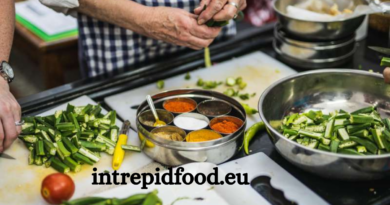How to Use a Spurtle for Perfectly Stirred Soups and Stews
If you’re looking to elevate your cooking game, it’s time to get acquainted with an often-overlooked kitchen tool: the spurtle. This simple yet versatile utensil is making waves in kitchens everywhere for its unique ability to stir soups and stews to perfection. But what exactly is a spurtle? And how can it transform your culinary creations? Join us as we dive into the world of this charming Scottish staple, unlocking its rich history and unveiling tips on how to use it effectively in your everyday cooking. Get ready to embrace the spurtle—it might just become your new favorite kitchen companion!
History of the Spurtle and its Uses in Scottish Cuisine
The spurtle boasts a rich heritage rooted in Scottish culinary tradition. Originating in the 15th century, this simple wooden tool was initially crafted for stirring porridge. Its unique design allowed for efficient mixing without lumps.
Historically, spurtles were made from various woods like beech or birch, prized for their durability and natural antibacterial properties. They became essential kitchen implements in Scottish households, symbolizing comfort food and communal meals.
As time progressed, the use of the spurtle expanded beyond porridge. Today, it finds its place not just in making soups but also stews and sauces. Home cooks cherish its versatility while professional chefs appreciate its ability to blend ingredients without altering textures too much.
Its connection to Scottish cuisine is undeniable, embodying both practicality and cultural significance as it continues to stir up flavors across generations.
Benefits of Using a Spurtle for Cooking
Using a spurtle in the kitchen offers numerous advantages that enhance your cooking experience. Its long, slender design allows for easy stirring without splattering. This makes it particularly useful when preparing soups and stews.
The smooth wooden surface of a traditional spurtle is gentle on pots and pans, reducing the risk of scratches or damage. You can enjoy your favorite cookware longer with this thoughtful tool.
Moreover, spurtles are great at reaching every corner of the pot, ensuring even mixing. Ingredients combine harmoniously, bringing out rich flavors in your dishes.
Another benefit is their versatility. Spurtles aren’t just for stirring; they can also help you serve food gracefully. Their unique shape adds an element of charm to any meal preparation or presentation.
Using a spurtle connects you to culinary traditions while making cooking more enjoyable and efficient in your modern kitchen.
Step-by-Step Guide on How to Use a Spurtle for Soups and Stews
Start by choosing your favorite pot. A heavy-bottomed one is ideal for even heating.
Once the ingredients are in, grab your spurtle. Its unique design allows you to reach every corner of the pot without scratching non-stick surfaces.
Begin stirring gently, using a figure-eight motion. This technique helps to incorporate flavors without mashing delicate ingredients.
As you stir, keep an eye on the consistency. The thin edge of the spurtle is perfect for scraping down any bits that stick to the sides.
For thicker soups and stews, use more pressure but avoid aggressive movements. You want everything combined beautifully without creating splatter.
Continue stirring until you achieve that perfect blend of textures and temperatures. Enjoy watching how easily it mixes everything together!
Tips for Choosing the Right Spurtle
When choosing the right spurtle, consider the material. Wooden spurtles offer a traditional feel and are gentle on cookware. Silicone or bamboo options provide flexibility and heat resistance.
Next, think about size. A longer spurtle is ideal for larger pots of soup or stew, while a shorter one works well for smaller batches.
Don’t overlook design features either. Some spurtles have flat edges that can help scrape down the sides of your pot effectively.
Consider aesthetics. A beautifully crafted spurtle can enhance your kitchen’s decor while being functional at the same time. Choose one that reflects your personal style!
Alternative Uses for the Spurtle in the Kitchen
While the spurtle shines in stirring soups and stews, its versatility extends far beyond that.
Use it to mix batters for pancakes or muffins. Its unique shape helps blend ingredients smoothly without overmixing, ensuring fluffy results.
If you enjoy making homemade sauces, a spurtle is perfect for whisking together your ingredients. The flat edge can scrape the sides of bowls effectively, leaving no sauce behind.
Need a tool to help with mashing? Try using your spurtle on soft vegetables like avocados or cooked potatoes. It gives you just the right leverage without creating too much mess.
You can even use it to serve dishes directly from pot to plate. Its elegant design adds a rustic charm while keeping portions neat and tidy.
With creativity in mind, this simple kitchen tool proves itself as an essential multitasker.
Conclusion
Using a spurtle can transform your cooking experience, especially when it comes to soups and stews. This versatile tool not only stirs but also enhances the flavors of your dishes. Its historical roots in Scottish cuisine add a touch of tradition to modern kitchens.
The benefits are clear: ease of use, effective mixing, and even stirring without scratching pots. Following our step-by-step guide ensures you get perfectly stirred soup or stew every time. Choosing the right spurtle is essential for maximizing its potential — whether you prefer wood or silicone, there’s an option that suits everyone.
Beyond stirring soups and stews, a spurtle can be used creatively for various tasks in the kitchen. From mashing potatoes to scraping bowls clean, this simple yet efficient tool proves its worth repeatedly.
Embracing the spurtle means embracing better cooking techniques while enjoying the rich culinary history it brings along with it. It’s more than just a utensil; it’s an invitation to explore new ways of preparing food that are both enjoyable and rewarding.




